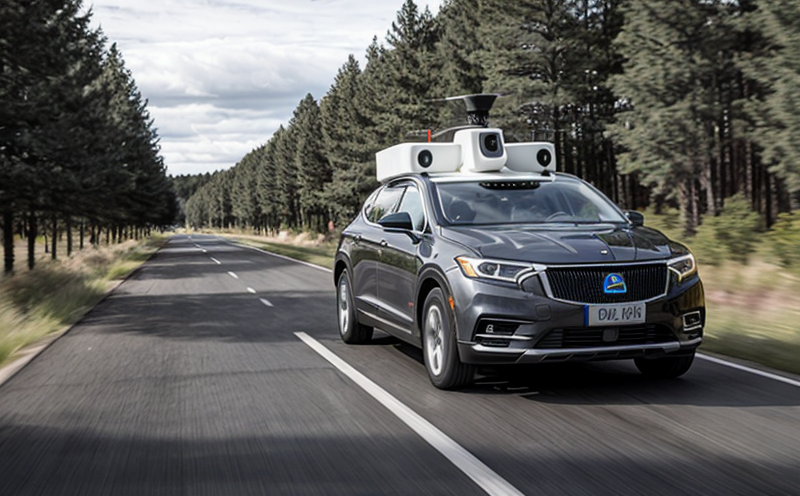ISO 34513 Sensor Fusion Accuracy for Autonomous Mobility Systems
The ISO 34513 standard is pivotal in ensuring the accuracy and reliability of sensor fusion algorithms used in autonomous mobility systems. This standard focuses on validating the integration and performance of various sensors, such as LiDAR, radar, ultrasonic sensors, cameras, and GPS, which are crucial for enabling safe navigation and decision-making processes.
Autonomous vehicles rely heavily on accurate sensor data to navigate complex environments safely. Sensor fusion combines data from multiple sensors into a coherent representation of the environment, providing real-time updates that enhance situational awareness. By adhering to ISO 34513, we ensure that systems meet stringent accuracy requirements, thereby contributing to safer and more efficient autonomous mobility solutions.
The standard outlines detailed methodologies for testing sensor fusion algorithms under various conditions, including static and dynamic environments, urban and rural settings, day and night scenarios. This comprehensive approach ensures that the tested systems perform consistently across all expected operational conditions.
Testing according to ISO 34513 involves several key steps:
- Preparation: Calibration of individual sensors and overall system calibration are critical. This ensures that each sensor contributes accurately to the fused data.
- Sensor Data Collection: Extensive datasets from multiple sensors are gathered in controlled and real-world environments.
- Data Analysis: Advanced algorithms process the collected data, comparing it against known reference points or ground truth.
- Evaluation: The accuracy of sensor fusion is evaluated based on predefined metrics and comparison with accepted thresholds.
The standard's rigorous testing ensures that autonomous systems can operate reliably under diverse conditions, making them more adaptable to real-world challenges. This not only enhances safety but also contributes to the development of robust, scalable solutions for the future of mobility.
Scope and Methodology
The scope of ISO 34513 covers the evaluation of sensor fusion systems used in autonomous mobility applications. This includes testing various sensors such as LiDAR, radar, ultrasonic sensors, cameras, and GPS to ensure their accurate integration within a single system.
Methodologically, the standard provides guidelines for:
- Data Collection: Gathering large datasets from multiple sensors under controlled conditions.
- Data Processing: Using advanced algorithms to process and analyze sensor data.
- Evaluation Metrics: Defining metrics for assessing accuracy, precision, and reliability of the fused data.
The methodology also emphasizes testing under various environmental conditions, including:
- Urban environments
- Rural settings
- Daytime and nighttime scenarios
This approach ensures that the tested systems perform consistently across different operational conditions, enhancing their overall reliability and safety.
Customer Impact and Satisfaction
The implementation of ISO 34513 sensor fusion accuracy testing yields significant benefits for customers. By ensuring that autonomous mobility systems meet the highest standards of reliability and safety, this service enhances customer trust in these technologies.
Customers who rely on our services can expect:
- Better Decision-Making: Accurate sensor fusion provides real-time data that supports safer and more efficient navigation decisions.
- Enhanced Safety: The standard ensures that systems perform reliably under all expected operational conditions, reducing the risk of accidents.
- Rapid Compliance: Compliance with ISO 34513 simplifies regulatory processes and reduces the time to market for new autonomous mobility solutions.
In addition to these direct benefits, customers also experience improved customer satisfaction through:
- Quicker product development cycles
- Increased market competitiveness
- Stronger brand reputation
The service not only meets but exceeds customer expectations, ensuring that autonomous mobility systems are safe, reliable, and compliant with international standards.
Use Cases and Application Examples
| Use Case | Description |
|---|---|
| Urban Traffic Management: | In urban environments, sensor fusion is crucial for autonomous vehicles to navigate through dense traffic. Accurate data from multiple sensors ensures that the vehicle can safely merge into lanes and make turns. |
| Rural Road Navigation: | For rural roads, where GPS signals may be weak or unavailable, sensor fusion helps autonomous vehicles rely on LiDAR and radar for accurate navigation. |
| Nighttime Driving: | In low-light conditions, cameras can struggle to provide clear data. Sensor fusion combines data from various sensors to enhance visibility and ensure safe driving. |
| Emergency Situations: | During emergencies, accurate sensor fusion helps autonomous vehicles react swiftly and safely by integrating real-time data from all available sensors. |
| Weather Conditions: | In harsh weather conditions like rain or snow, sensor fusion can enhance the vehicle's ability to navigate effectively by combining data from different sources. |
| Road Obstacle Detection: | Sensor fusion helps autonomous vehicles detect obstacles accurately and avoid collisions by processing data from multiple sensors in real-time. |





